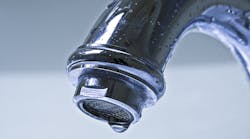Latest from Green
The Heat Pump Water Heater Payback
Sponsored
Green is often thought about as something you can implement in a new building, but Kohler and Whirlpool demonstrated at the recent Greenbuild Show in Washington how you can drastically reduce water use in an old house. An 87-year-old house near the Purdue University campus to be exact.
Whirlpool has done a lot of work on the water-conservation side of its appliances and they needed Kohler for its residential plumbing expertise. The two companies are collaborating on the ReNEWW House (Retrofit Net zero Energy Water Waste) that’s currently occupied by Purdue students, so the firms’ can study real world operating conditions. The goal is net-zero water usage.
“We recognize that to further extend the benefits of water-efficient fixtures and faucets while maintaining optimum performance, we need to look at home water consumption holistically,” Rob Zimmerman, Kohler Sustainability Senior Channel Manager, said six months ago when the project was first announced. “We hope that by combining our engineering resources with those of Whirlpool’s to understand the technical challenges of creating a ‘net -zero water’ house, we can develop new insights for designing home plumbing, water storage and treatment systems that further reduce water use and better protect our water supplies.”
The kinds of sensors developed for the Internet of Things help the process. Zimmerman told me that the house is collecting millions of data points. If someone turns on the kitchen sink to rinse out a coffee cup, it previously would have been missed because that’s not enough water to spin the meter.
The house contains a variety of water technologies, such as a rainwater recovery and reuse system from Rainwater Management Solutions. By the way, there are only a handful of people in the country that I consider to be the preeminent rainwater recovery and reuse experts, and RMS founder and CEO David Crawford is one of them. E.W. “Bob” Boulware, P.E., Design-Aire Engineering, is also part of that handful and he is likewise a partner in ReNEWW House. CleanBlu supplied the water recycling equipment. The house also has two drain water heat recovery systems, one vertical and one horizontal, including a copper unit from Power-Pipe.
According to research conducted by Whirlpool, there’s money to be made here.
Whirlpool surveyed a random sample of more than 1,200 homeowners to determine their water and energy efficiency preferences.
- Nearly all respondents (94 percent) said reducing household energy consumption is top of mind, and nine out of 10 people say they’d like to be better about conserving water and energy.
- More than eight in 10 homeowners said reducing water use in their home and making their home more sustainable is important to them, while also admitting they would like to be better about conserving water and energy.
- Homeowners most interested in water efficiency are 35 years old or younger with a college degree and children.
There doesn’t seem to be much of an “ick” factor at work either. Seventy-four percent of respondents agree that it’s safe to reuse household water from sinks or showers for flushing toilets or outdoor irrigation. Fifty-eight percent would reuse water from sinks or showers to reduce their household water consumption by half.
Of course that’s hypothetical. Who raises his hand in favor of waste? But we can take comfort in the fact that homeowners are in favor of this technology. Now we must convince them to buy it.
Robert P. Mader
Bob Mader is the Editorial Director for Penton's mechanical systems brands, including CONTRACTOR magazine, Contracting Business and HPAC Engineering, all of which are part of Penton’s Energy and Buildings Group. He has been with CONTRACTOR since 1984 and with Penton since 2001. His passions are helping contractors improve their businesses, saving energy and the issue of safeguarding our drinking water. He is a graduate of the University of Notre Dame with an A.B. in American Studies with a Communications Concentration.


